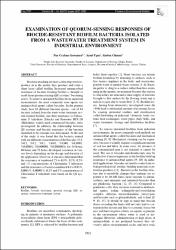EXAMINATION OF QUORUM-SENSING RESPONSES OF BIOCIDE-RESISTANT BIOFILM BACTERIA ISOLATED FROM A WASTEWATER TREATMENT SYSTEM IN INDUSTRIAL ENVIRONMENT
Abstract
Bacteria attaching surfaces contacting water reproduce in n the matrix they produce and form a slime layer called biofilm. Increased antimicrobial resistance of bacteria forming biofilm is thought to result from quorum sensing (QS) systems' becoming active. To remove unwanted biofilms from industrial environments, the most commonly used agents are antimicrobial agents called biocides. In the present study, how 61 different bacteria species out of 84 bacteria isolated from the waste water treatment system formed biofilm, and their resistance to Chloramine T trihydrate (Merck) and Penwater BC8120 (Hidrokim), widely used commercial biocides, were investigated. In addition, the relationship between QS systems and biocide resistance of the bacteria identified to be resistant was determined. At the end of the study, it was found that the bacteria treated with ten different concentrations of the biocides (%1, %0,5, %0,2, %0,1, %0,01, %0,001, %0,0001, %0,00001, %0,000001, %0,0000001) for 24 hours, 48 hours and 72 hours developed resistance at various levels depending on the dosage and duration of the application. However, it was also determined that the resistance of numbered 73 to 0,1%, 0,2%, 0,5% and 1% concentrations of Chloramine T trihydrate and the resistance of bacteria numbered 84 to 0,01%, 0,0001%, 0,00001%, 0,2% and 1% concentrations of Chloramine T trihydrate were based on the QS systems.


















